Navigating the world of utility terrain vehicles (UTVs) can be both exciting and overwhelming. If you’re in the market for one, two models that may have caught your eye are the Honda Pioneer and the Kawasaki Mule. Both vehicles offer their unique set of features tailored to different tasks and terrains, making the choice between them a common dilemma for UTV enthusiasts. Whether you’re looking for a workhorse for your property or a companion for your off-road adventures, understanding the nuances of these models is key to making an informed decision.
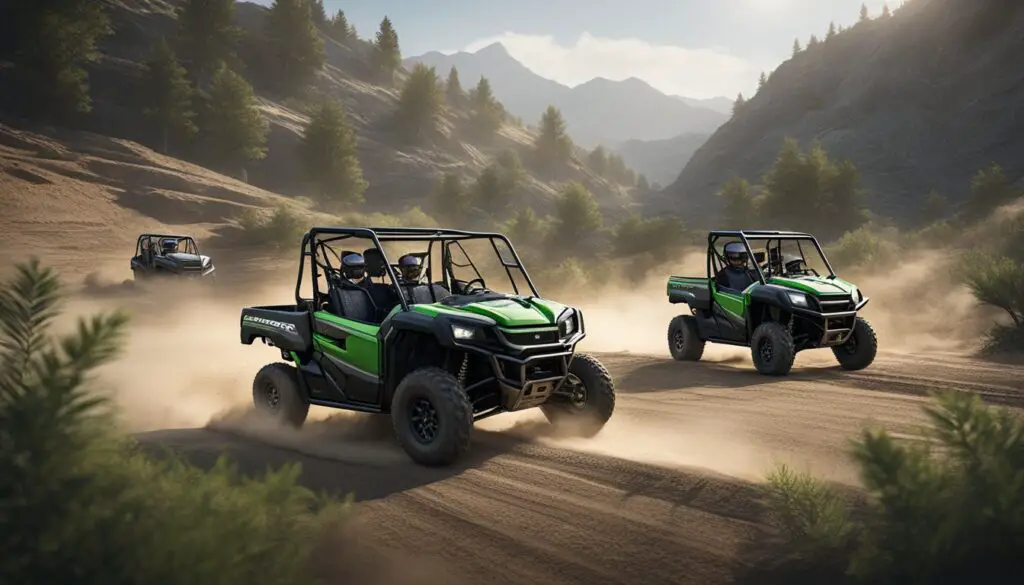
The Honda Pioneer is known for its robust engine and impressive horsepower, making it a favorite for those of you seeking a bit more power and speed on varying landscapes. In contrast, the Kawasaki Mule is recognized for its durability and comfort, often preferred for less intensive tasks and mellow trail rides. Both UTVs come with their proprietary technologies in terms of transmission, handling, and comfort, highlighting their distinct approaches to design and performance.
As you consider your options, it’s important to weigh up the specific features each UTV offers, such as engine performance, handling, suspension systems, cargo capacities, and additional amenities. Your intended use, whether it’s hauling heavy loads, cruising through trails, or both, will significantly influence which model will best suit your needs. With each offering a unique driving experience, the choice comes down to what you value most in a UTV.
Honda Pioneer Vs. Kawasaki Mule Overview
When exploring the great outdoors, you may consider a reliable UTV for utility and recreation. The Honda Pioneer and Kawasaki Mule are counted among the top picks for side-by-side vehicles. As you ponder which to choose, a side-by-side comparison may come in handy.
Engine and Performance:
- Honda Pioneer: Boasts a 999cc engine with 72 horsepower, making it suitable for a variety of terrains and providing ample power for recreational activities.
- Kawasaki Mule: Equipped with a 4-stroke, 3-cylinder OHV, liquid-cooled gas engine with 45 horsepower, the Mule is tailored for smooth trail rides and tasks around your property.
Utility and Comfort:
- The Mule is recognized for its quiet operation, enhancing your hunting trips without startling wildlife.
- The Pioneer aims to combine comfort with performance, potentially offering a smoother ride on diverse terrains.
Price Considerations: Starting pricing for these UTVs can influence your decision:
- Kawasaki Mule: About $9,000 for the base model.
- Honda Pioneer: Close to $10,000 for its base model.
Prices will vary with trim levels and added accessories but be assured that both brands boast durability and reliability.
Consider your intended use, whether it’s for leisurely rides, handling tough terrain, or managing tasks. You’re likely to find a match in either the Pioneer for more energetic outings or the Mule for quieter, steadier work.
Comparative Analysis of Specifications
When considering the Honda Pioneer and Kawasaki Mule, you’ll find distinctive differences and unique advantages across various specifications like engine power, comfort, and handling. Let’s break these down for a head-to-head comparison.
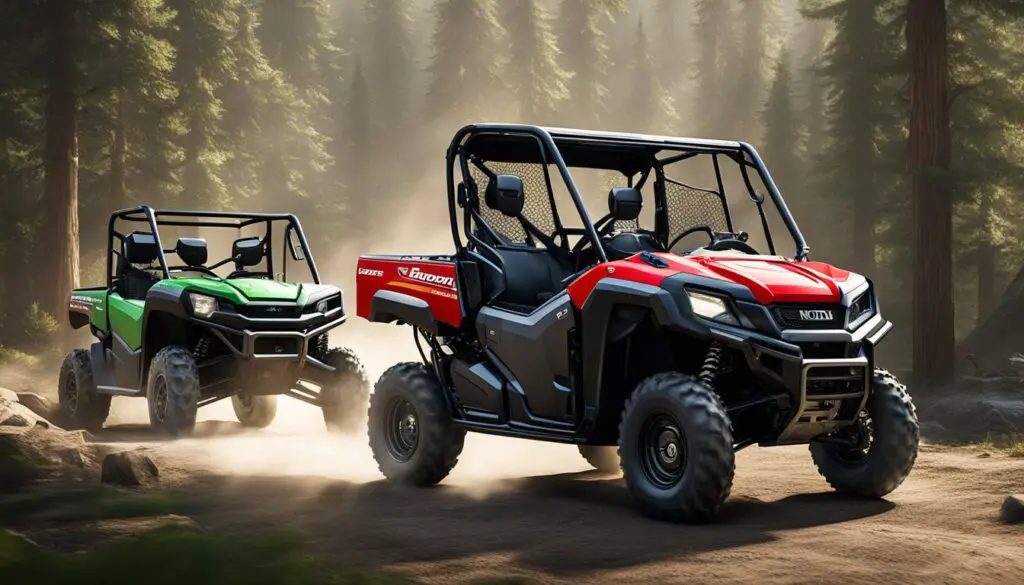
Engine and Performance
- Honda Pioneer: Offers a 999cc engine with 72 horsepower for robust performance.
- Kawasaki Mule: Features a less powerful 4-stroke, 3-cylinder OHV, liquid-cooled gas engine with 45 horsepower, prioritizing efficient, consistent handling over raw power.
Transmission and Driveline
- Honda Pioneer: Uses a geared transmission system capable of tackling steep inclines.
- Kawasaki Mule: Equipped with a continuously variable transmission (CVT) for smooth, stepless gear transitions and reliable 4WD traction.
Handling and Traction
The Mule’s CVT and the Pioneer’s geared transmission both affect handling, especially off-road. The Pioneer’s torque and power can translate to more aggressive off-road capabilities, while the Mule’s setup is optimized for stability and control.
Dimensions and Weight
Honda and Kawasaki side-by-sides vary in size, impacting how you’ll navigate trails:
- Ground Clearance: Specified measurements can determine off-road capability.
- Weight: Heavier models might affect maneuverability but also can provide stability.
Payload and Towing
- Bed Capacity: Both the Mule and Pioneer offer tilt beds, with the Kawasaki known for utility-focused design.
- Towing Capacity: Towing specs are important for work or play, and each has ratings reflective of their engine and design priorities.
Comfort and Conveniences
Your ride quality is influenced by seating, legroom, and extras:
- Seating: The cushioning and support of seats in both the Mule and Pioneer affect long-term comfort.
- Conveniences: Features like easily accessible controls and storage options can enhance your experience.
Accessories and Customization
From functionality to aesthetics, both models provide a range of accessories:
- Roof and Windshield: Optional for weather protection and comfort.
- Custom Add-ons: These affect both utility and personalization of your side-by-side.
Pricing and Value
- Starting MSRP : Generally starting around $9,000 for Kawasaki Mule models and $10,000 for Honda Pioneer models.
- Value: Prices increase with higher trims and accessories, but both brands are recognized for their durability and retention of value.
Reliability and Maintenance
Consider the warranty and maintenance schedule for each side-by-side. While specific reliability metrics might vary, both Honda and Kawasaki have reputations for producing long-lasting vehicles backed by supportive maintenance services.
Models and Options
- Honda Pioneer 1000-6 : Among the lineup, a notably versatile model with options for seating and cargo.
- Kawasaki Mule SX: A compact option that highlights Kawasaki’s range of models, catering to different uses and preferences.
Usage Scenarios
When choosing between the Honda Pioneer and the Kawasaki Mule, it’s important to consider how you’ll be using your vehicle. Will you be navigating rough terrain? Do you need a reliable workhorse for tough jobs? Are recreational activities your priority? Or is everyday comfort more your concern?
Performance on Rough Terrain
The Honda Pioneer boasts a 999cc engine producing 72 horsepower, ideal for powering up hills and taking on challenging off-road conditions. Its geared transmission provides you with precise control, enabling you to tackle rough terrain confidently. In contrast, while the Kawasaki Mule isn’t necessarily designed as an off-road powerhouse, its 45 horsepower engine is quite capable for mellow trail rides and does offer a smooth driving experience across uneven landscapes.
Utility for Work
As a work machine, the Kawasaki Mule shines with its off-road capability and three-cylinder OHV liquid-cooled gas engine, which is specifically designed for reliability and longevity. The Honda Pioneer steps up with added power, suitable for more demanding work scenarios, and is equipped with paddle shifters, allowing for a more engaged utility vehicle operation. Both are excellent in terms of work capabilities, but you’ll find the Pioneer has the edge in tasks requiring more grunt.
Convenience for Recreational Use
Your recreational adventures might demand a balance of power and convenience. The Honda Pioneer can comfortably seat passengers and is trusted for its reliability, especially in models like the Pioneer 1000-6, making it great for outings, including hunting trips. On the flip side, the Kawasaki Mule—despite being less noisy—is straightforward and practical, ensuring a hassle-free experience when it’s more about utility than thrill.
Comfort in Daily Operations
When your usage involves daily operations, comfort becomes a significant factor. The Honda Pioneer‘s real transmission may produce shifts that feel a bit clunky at times, but it generally provides a comfortable ride. With the Kawasaki Mule, you’ll get a quieter performance, an aspect that can be appreciated whether you’re spending long hours working or enjoying a leisurely ride around your property.
Durability and Long-Term Performance
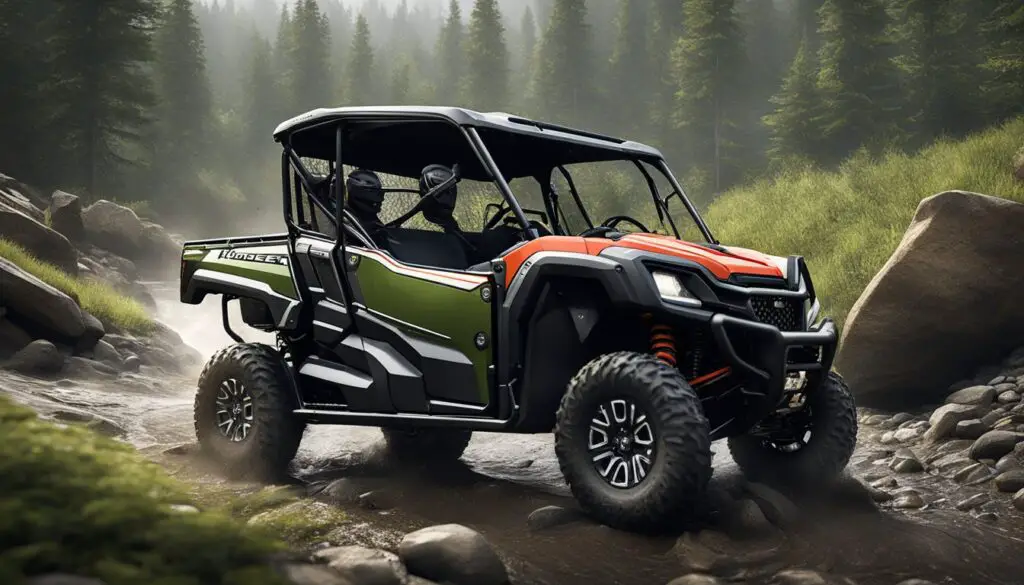
When you are examining the durability of the Kawasaki Mule and the Honda Pioneer, you’re evaluating their ability to withstand the test of time and the rigors of off-road conditions. Both vehicles are designed with a solid frame construction, durable body panels, and are known for their reliability in the long run.
Kawasaki Mule
- Engine: The Mule comes with a sturdy gas-powered engine, built to handle consistent use over various terrains.
- Cooling System: While some models offer an air-cooled engine, higher-end Mules like the Pro-MX are liquid-cooled, enhancing their ability to perform under stress without overheating.
Honda Pioneer
- Engine: It’s equipped with a larger engine capacity that can deliver a higher horsepower, suggesting a potential edge in performance-based durability.
- Transmission: A real transmission system that mimics automotive standards provides you with smoother rides and may contribute to lesser wear and tear over time.
In terms of versatility, both vehicles adapt well to a range of activities, from light trails to demanding tasks on a property. As for off-road capabilities, the suspension systems and build quality of both the Mule and the Pioneer allow you to take on challenging terrains with confidence.
The key factors you might consider when assessing the resilience of these vehicles are:
- Engine robustness and maintenance needs
- Cooling system efficiency to prevent damage during heavy use
- Structural integrity and how it withstands environmental stressors
- Use of technology to prolong the vehicle’s operational life, such as advanced transmissions
Safety and Control Features
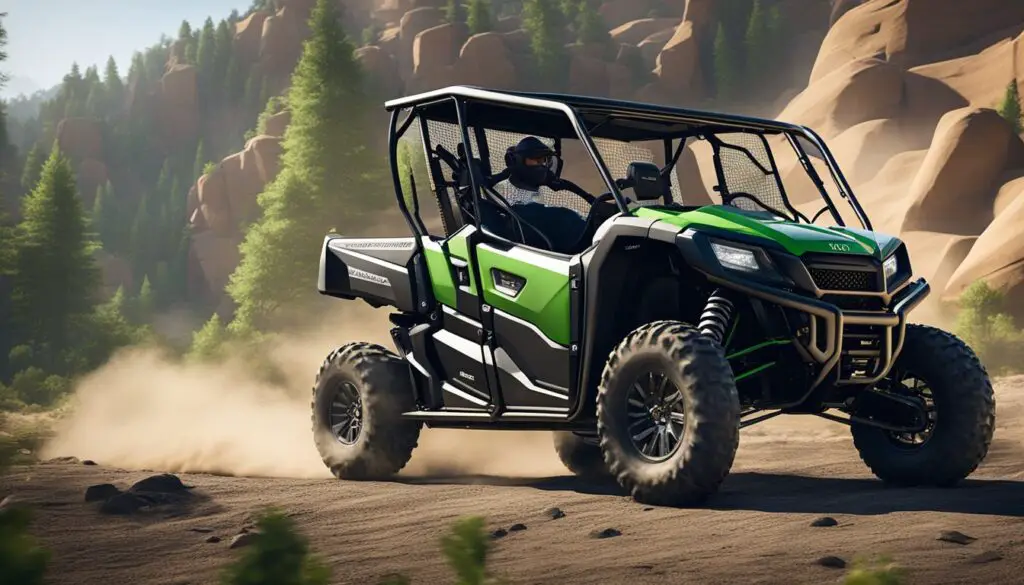
When comparing the Honda Pioneer and Kawasaki Mule, consider how each vehicle manages safety and control, especially since you’ll be tackling a variety of terrains.
The Kawasaki Mule features power steering on select models, which enhances maneuverability and reduces driver fatigue. This is particularly beneficial when navigating through tight spaces or during long workdays on your property. Four-wheel drive is a standard in the Mule lineup, offering you improved traction in mud, sand, and other challenging conditions.
On the other side, the Honda Pioneer also offers power steering with its higher-end models, facilitating precise control and comfortable handling. The Pioneer’s four-wheel drive system is robust and includes a lockable differential, which is a bonus when you encounter slippery slopes or need to climb over obstacles.
Side by side, both vehicles have built-in safety features such as sturdy roll cages and seat belts, providing you with a protective framework should you encounter unexpected bumps or turns. Here’s a quick comparative glance:
- Kawasaki Mule:
- Optional power steering
- Standard four-wheel drive
- Protective roll cage
- Honda Pioneer:
- Power steering on select models
- Four-wheel drive with lockable differential
- Seatbelts and roll cage for enhanced safety
Remember to always check specific model details to ensure that the features you need for safety and control are included in the vehicle you are considering. Your peace of mind while riding is paramount.
Final Recommendations
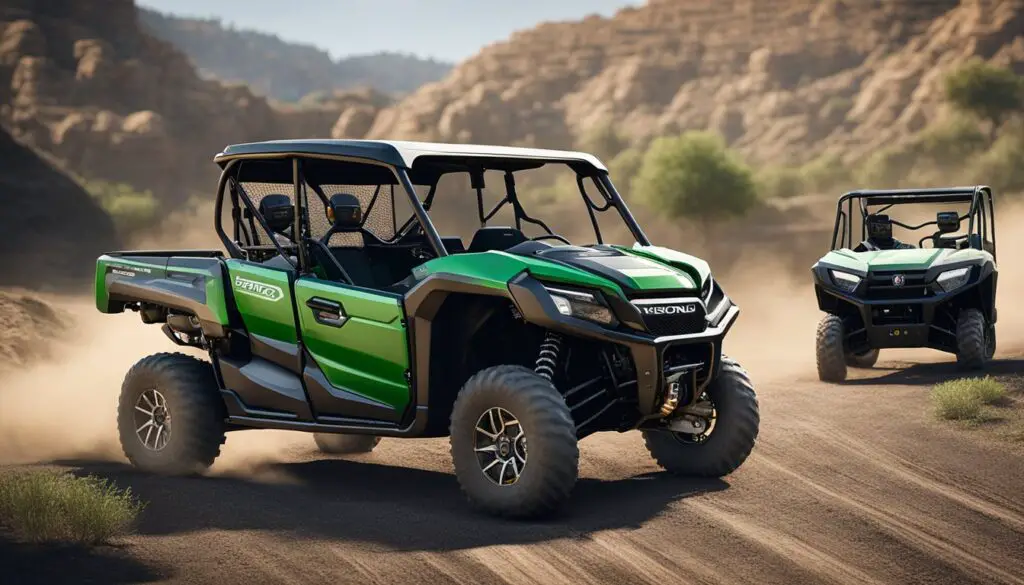
When choosing between the Honda Pioneer and the Kawasaki Mule, your decision should focus on your specific needs and preferences.
- If you prioritize rugged performance and power for more intensive tasks or recreation, the Honda Pioneer, with its 999cc engine generating 72 horsepower, might be your go-to option. You’ll find this useful when tackling challenging terrains or when you require that extra burst of power.
- On the other hand, the Kawasaki Mule is well-suited for general property work and mellow trail rides with its 45 horsepower engine. Its 3-cylinder OHV design offers reliability and sufficient power for everyday tasks.
Here’s a quick reference for you:
| Feature | Honda Pioneer | Kawasaki Mule |
|---|---|---|
| Engine Power | 72 hp (999cc) | 45 hp |
| Performance | Better for intense activities | Adequate for everyday use |
| Transmission | Geared | CVT |
| Suited Environment | Challenging terrains | General property, trails |
Remember, while the Pioneer may come at a higher price point, that investment goes towards more horsepower and a geared transmission which could be crucial for certain activities. In contrast, the Mule offers a more budget-friendly option without compromising on the basics.
Take into account factors such as how rugged the terrain you plan to tackle is, if performance in extreme conditions is vital, and your comfort with the type of transmission when making your final choice. Your preference in these areas should guide your decision for an optimal off-road experience.
Conclusion
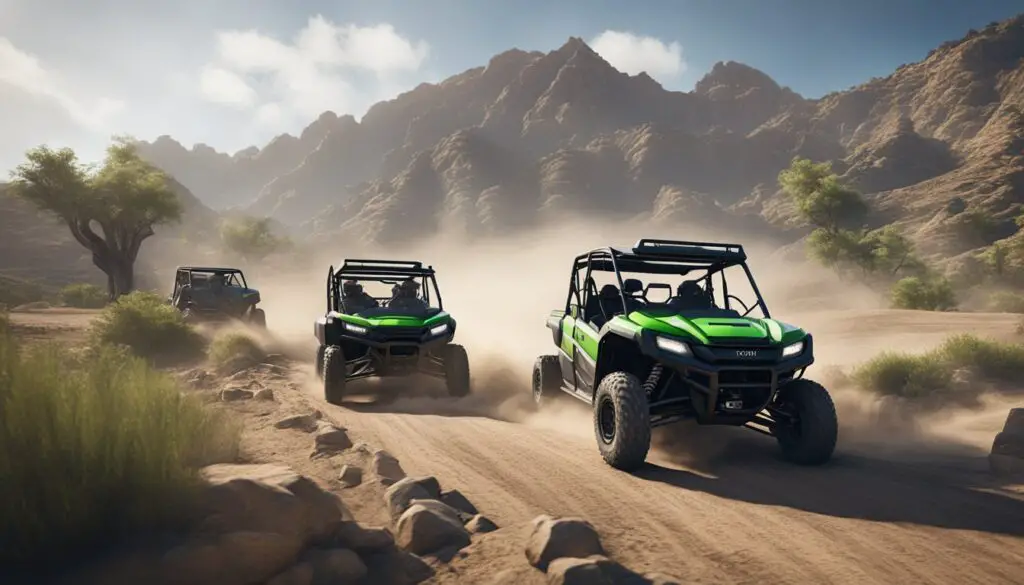
When deciding between the Kawasaki Mule and the Honda Pioneer, your choice hinges on what you value most in a utility vehicle. The Kawasaki Mule is renowned for its:
- Robust build
- Cost-effectiveness
- Suitable for work-related tasks
On the other side, the Honda Pioneer shines with:
- Higher horsepower
- Enhanced features for tougher trails
- A reputation for reliability
Price, as an important consideration, varies with models and features of each vehicle. The Mule starts at a more affordable point, while the Pioneer tends to be priced higher largely due to additional capabilities and power.
| Feature | Kawasaki Mule | Honda Pioneer |
|---|---|---|
| Engine Power | Adequate for work and light trail riding | More suited for power-intensive tasks |
| Transmission | Real transmission that may enhance off-road performance | |
| Reliability | Strong track record | Also known for reliability |
| Value for Money | Good overall value | Comes with a higher price tag, possibly justified by extra features |
Your specific needs should dictate your decision. If you’re seeking a reliable workhorse for your property, the Mule might be your best bet. Conversely, if you’re looking for a bit more excitement and capability on the trails, the Pioneer could be the way to go. Remember to consider the long-term costs of ownership, including maintenance and aftermarket support, before making your final selection.
Frequently Asked Questions
In your journey to decide between the Kawasaki Mule and the Honda Pioneer, you likely have a number of questions regarding their specifications, suitability for beginners, pricing, performance, reliability, and longevity. Let’s explore these common questions to help steer your decision.
What are the defining differences in specs between the Honda Pioneer and Kawasaki Mule?
The Kawasaki Mule is often characterized by its 4-stroke, 3-cylinder OHV, liquid-cooled gas engine, putting out 45 horsepower. In contrast, the Honda Pioneer typically boasts a 999cc engine which produces 72 horsepower. These specs may imply that the Pioneer could have superior power output.
Which is more suitable for beginners, the Honda Pioneer or the Kawasaki Mule?
For beginners, the Kawasaki Mule might be more suitable due to its user-friendly features and sufficient power for basic trail rides and property work. Its gentle power delivery can be less intimidating for new users.
How does the price comparison between the Honda Pioneer and Kawasaki Mule pan out?
Price-wise, the Kawasaki Mule starts at a lower entry point, around $9,000 for a basic 2-passenger model, whereas the Honda Pioneer’s starting price for a similar seating capacity is roughly around $10,000. Depending on trim levels and accessories, the prices can vary for both models.
Between the Honda Pioneer 1000 and Kawasaki Mule, which offers better performance?
The Honda Pioneer 1000, with its higher horsepower engine, is typically perceived as offering better performance, especially for those seeking more power and a vehicular experience beyond basic utility tasks.
In terms of reliability, how does the Honda Pioneer stack up against the Kawasaki Mule?
Honda is known for reliability, and the Pioneer benefits from this reputation. The experience with other Honda vehicles like the Foreman 500 often influences buyers’ confidence in the Pioneer’s reliability.
How does the longevity of the Kawasaki Mule compare to similar utility vehicles like the Honda Pioneer?
Both the Kawasaki Mule and Honda Pioneer are built with durability in mind. Users report high satisfaction with the longevity of both vehicles when properly maintained, making either a sound investment for consistent use over time.

Leave a Reply